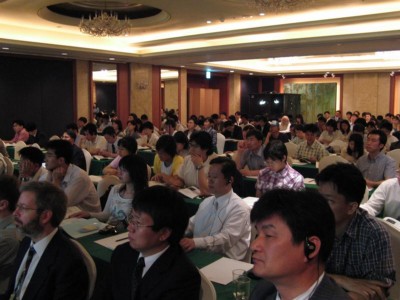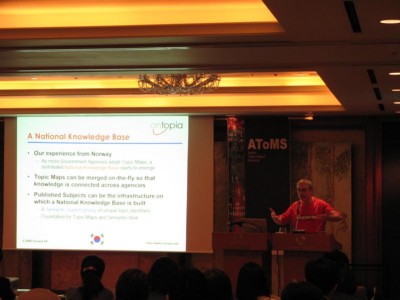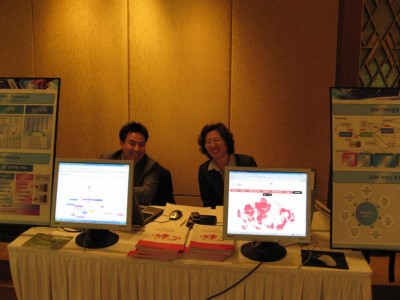AToMS!
The last day of the week in Seoul was given over to AToMS, Asian Topic Maps Summit, a one-day conference devoted to Topic Maps. The conference was organized by the two Korean standards agencies (KATS and KSA), and attracted more than 200 attendees. I arrived a little late (in order to get some sleep), and by then it was hard to get a seat.

Audience |
Simultaneous translation
One interesting feature of this conference was that there was simultaneous translation throughout. Two people sat in a black glass box at the back (just visible in photo above), taking turns to translate. Delegates could get a little black box with an earphone attached, which received two radio channels, one with the speaker's voice, and another with the translation. Talks in Korean were translated to English, while talks in English were translated to Korean.
I only heard the translation of one of the talks, and it seemed very good to me, although I wondered if some things might not have been left out. There was also a slight time lag, inevitably, so what the English voice was talking about might not be the same as what the speaker was pointing to at that moment. Still, it did seem to work quite well.
Keynotes
The first speaker was Sam Oh, who did the introduction to Topic Maps. I only arrived at the end of this, and the printed slides are in Korean, so I can't say much about it.

Steve evangelizing |
Sam was followed by the first (of two) keynote speakers, which was Steve Pepper. Steve spoke wearing the t-shirt of the supporters of the Korean national soccer team, which had played 0-0 against Norway (of all countries!) the night before. Steve started by observing that this was definitely not good enough if Korea was to win the world cup (and I can only agree). He then went on to his talk, which focused on giving real-world examples of the use of Topic Maps, with some general observations on the advantages of Topic Maps interspersed in between the rest. (I think the organizers intend to publish the slides on the AToMS site, so you should be able to see them there eventually. I'll update this blog entry with links when they are there.)
The second keynote speaker was Sung Hyon Myaeng, also wearing the same red t-shirt, who spoke on techniques for natural language processing, and their application to Topic Maps. I was busy polishing my own slides through most of his presentation, but listened in to the simultaneous translation from Korean.
Exhibition

INEK booth |
There were two exhibitors at AToMS, both quite interesting. One was INEK, our Korean partner, which has done a lot to promote Topic Maps in Korea, and a sponsor of the conference. INEK specializes in library systems, and has the majority of the Korean market. They were showing Korean topic maps in Omnigator and Ontopoly, and presented SKIM, their Topic Maps-based information management application. They also had a presentation on SKIM in the post-lunch session.
The other exhibitor was Frotoma, a new Korean Topic Maps software vendor with venture capital backing. The name is short for "Frontier of Topic Maps", but whether they are at this frontier or not I never found out, unfortunately, for reasons soon to be explained.
Lunch

Lunchroom |
The lunches at the ISO meetings were uniformly great, but at AToMS there was a separate speaker's lunch at which the organizers really overdid themselves. It was held in a special suite of the Lotte hotel that would not have shamed a European royal palace, with a lovely view of a garden with a waterfall in it. (A garden! And waterfall! In the middle of downtown Seoul, which is so crowded that many of the shopping malls are underground...)
The food was of course also great, and the lunch consisted of no less than seven dishes, plus fruit to round it all off. I, once again, ate more than was good for me, and thoroughly enjoyed myself.
The post-lunch speakers
The first speaker after lunch (never an easy position on the program) was Robert Barta, describing his experiences with developing open source Topic Maps software, and using it at Bond University. I was not able to give this presentation the attention it deserved, as eventually the excessive lunches (and dinners) caught up with me, and my stomach rebelled. I won't go into detail, but I definitely did not feel well.
As a result, I only caught bits of what Graham Moore had to say about the Norwegian Postal Service, which is using NetworkedPlanet's software to create a new intranet. The case study sounded quite interesting, but my thoughts were, frankly, elsewhere. He was followed by Eunwhan Jung of Frotoma, but by then I, too, was elsewhere, unfortunately.
After this it was my turn to speak, which I did. I thought it went reasonably well. Naito-san afterwards told me I seemed "not cheerful", but then I definitely was not. There were three more speakers after me, but I spent the rest of the day in bed, unfortunately.
Then followed a day with some sightseeing, and then the long flight home.

The Han river |
Similar posts
TMRA 2006 — day 1
Like last year, I will try to do a semi-live blog report from the TMRA 2006 conference on Topic Maps in Leipzig
Read | 2006-10-11 09:20
ISO meeting in Seoul, day 2
Day 2 of the Seoul meeting started with the opening plenary, where much attention was given to the standardization of Open Document Format (ODF) and OpenXML
Read | 2006-05-30 07:34
ISO meeting in Seoul, day 3
The meeting is now beginning to settle into a kind of daily rhythm that seems to run: two separate WG3 meetings, enormous lunch, plenary WG3 meeting, vast dinner, drinks, sleep, then start over
Read | 2006-06-01 06:03
Comments
JInie Min - 2006-06-06 16:32:01
Lars! You made your Trip to Han-River. I was worry about your health, but you regained your health. That's Good! After you left to your home, Seoul has been had really fine day still, I mean, without any fog and clouds. If you were be here in this week, it'll be beeter, I think. ^0^ Enjoy your time~~~ Lars.